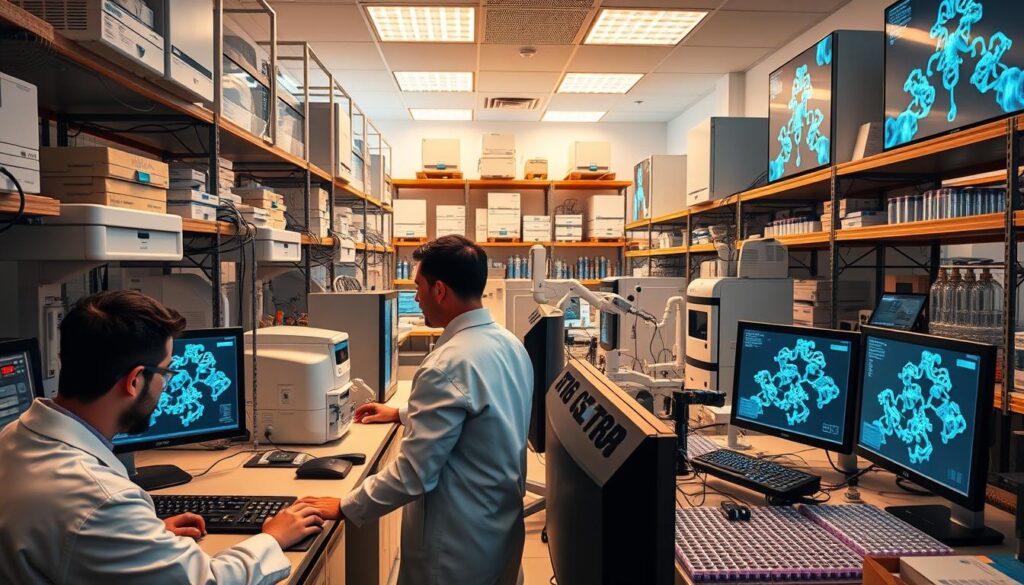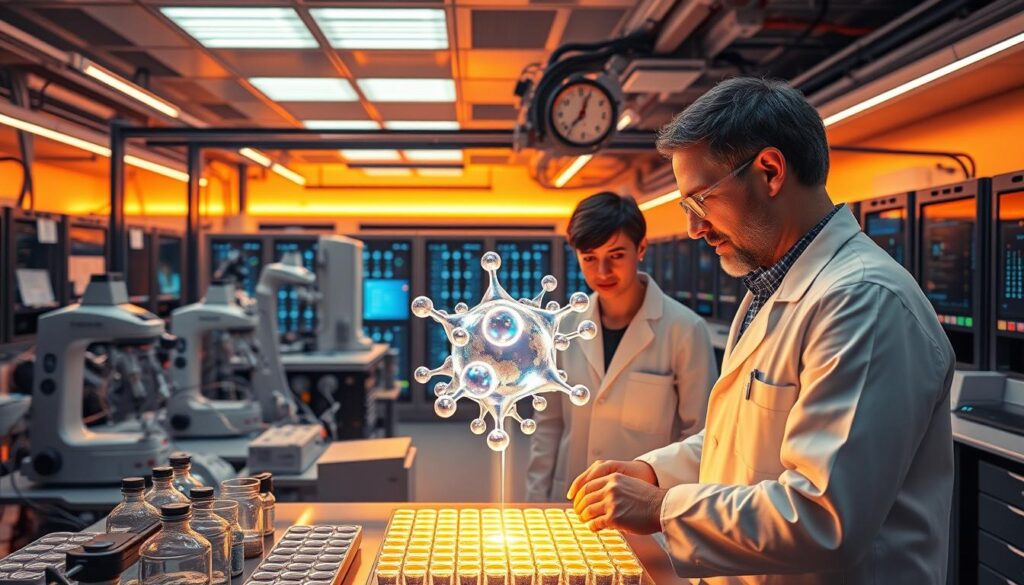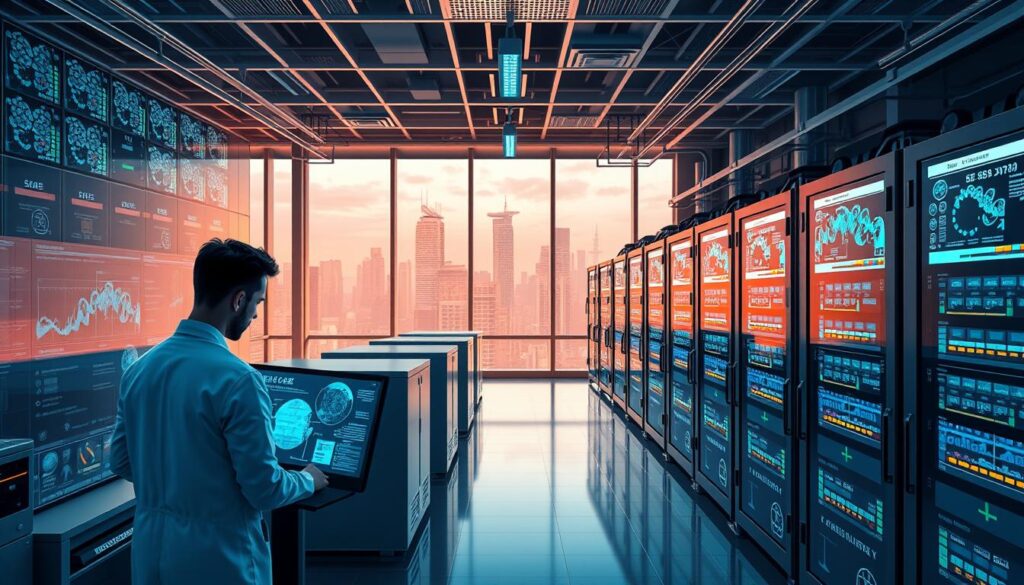Have you ever thought about how AI in drug discovery could change healthcare? By 2025, AI in drug development is set to become a reality. It could change the whole pharmaceutical industry.
Historically, the sector was slow to adopt new technologies. But now, companies see the value of AI in making drugs. The FDA has received over 300 AI-enhanced drug submissions since 1995. Big partnerships, like Immunai’s $18 million deal with AstraZeneca, are showing the way forward.
These changes will not only shape the future of drug development. They also show how crucial secure data handling is with AI.
Table of Contents
The Current State of Drug Discovery and Development
The world of drug discovery and development is getting more complex. It often takes over a decade and a lot of money. The cost to make a new drug is over US$1 billion, showing the big challenges researchers face.
For every drug that makes it, nine fail in clinical trials. This means only about 10% of drugs succeed. This shows we really need new ways to find drugs.
Eroom’s law points out that drug discovery costs keep going up. The money needed for new treatments doubles every nine years. This makes companies look for new ways to find drugs faster and better.
AI is seen as a big help. It could make finding drug candidates faster by a third. It also makes simulating clinical trials ten times quicker.
Working with places like Keio University gives access to lots of clinical data. This data is key for AI to find new drug targets. Companies like Lantern Pharma use AI to look through huge amounts of data, over 60 billion points on cancer.

AI could make finding new drugs much more efficient. If it can cut down trial failures from 90% to 80%, it would make drug discovery twice as good. Partnerships, like Eli Lilly and Isomorphic Labs, show the industry’s push to use AI for better results. They are making big steps towards the future of drug making.
Understanding the Role of AI in Drug Discovery
AI is changing how we find new drugs. It helps solve big problems that slow down old ways. Making a new drug takes over 10 years and costs about $2 billion. Sadly, about 90% of these drugs fail in human trials.
AI looks at huge amounts of data to find good drug candidates. It also predicts how well drugs will work. This makes finding and testing drugs safer and faster.
AI is also key in making treatments just for you. It looks at your genome to find the best treatments. This means treatments are less toxic and work better.
AI helps mix different drugs to work better together. It’s also making sure more people from all backgrounds are in clinical trials. This is thanks to AI tools like Antidote, which help find patients faster.
But AI needs good data to work well. Bad data can lead to bad results. So, keeping data clean is very important.
Even though AI hasn’t made a drug yet, it’s getting closer. It will soon be a big part of finding new drugs. This will make finding and making drugs much faster and cheaper.
The biopharma industry is getting ready for a big change. AI will make finding new drugs much faster. It’s expected to save up to $28 billion a year. This will help both researchers and patients all over the world.

Machine Learning and Its Impact on Pharmaceuticals
Machine learning is changing how drugs are made. It makes drug discovery faster and cheaper. Before, it took 13 to 15 years to develop a drug, and only 10% got approved. Now, machine learning helps analyze data quicker and predict better.
Computational drug design is getting better. Scientists can find new drug targets and make molecules more precise. For example, generative biology has made finding antibodies twice as fast. With over 10^60 possible compounds, machine learning opens up new drug possibilities.
Working with tech giants like NVIDIA boosts machine learning in pharma. This partnership shows how advanced computing is changing research. For example, Amgen’s AMPLIFY model is faster and cheaper than others, showing the power of machine learning.
Machine learning also helps in finding patients for clinical trials. It can make this process up to 50% faster. The FDA is watching these changes closely, supporting the use of AI in drug development.

Transformative Drug Discovery Algorithms
AI technology is changing how we find new medicines. About 90% of drug ideas fail early on. New AI methods help guess which drugs might work, speeding up the search.
The “lab in a loop” approach is a big change. It uses lots of data from labs and studies. This way, AI can quickly test many new drug ideas, making research better.
Companies like Roche are working with tech giants like AWS and NVIDIA. They’re improving how AI finds new medicines. AI drugs are doing well in early tests, with an 80% to 90% success rate.
More AI drugs are moving into human tests, from just three in 2016 to 67 in 2023. This shows how fast AI is changing medicine. AI could make finding new medicines faster and better, helping millions soon.

Predictive Modeling in Drug Discovery
Predictive modeling is key in making drug development faster and more efficient. Over 90 percent of drug candidates fail in clinical trials. This makes it crucial to make smart choices early on.
It uses past data and advanced computer methods to guess how well a drug will work. This helps researchers pick the best drugs to work on.
AI has changed how scientists check for drug risks. It helps spot dangers like drug-induced heart problems and liver issues. Tools like DICTrank Predictor and DILIPredictor show how well these models work.
They find drugs that might be harmful in animal tests. This saves time and money by avoiding failures later on.
Machine learning is also changing how we understand how drugs work in the body. Tools like BioMorph use images and cell health data. This makes finding good drug mechanisms easier.
It helps decide where to focus drug discovery efforts. This leads to a “fail faster” approach.
Going from finding a molecule to getting a drug to market can take over ten years. Predictive modeling cuts this time down. It uses AI to quickly check many drugs.
Platforms like DeepTox and MoleculeNet make checking for toxicity faster. This speeds up finding new drugs. It also helps understand how drugs work and find biomarkers.
AI Applications in Healthcare
AI in healthcare goes beyond finding new drugs. It makes patient care better and more efficient. AI uses big data like patient histories and genes to tailor treatments. This makes treatments work better.
AI helps manage big data, which is key to cutting down on wasted healthcare spending. It makes clinical trials and patient data easier to handle. This reduces mistakes and speeds up getting new treatments to patients.
AI can guess which patients will benefit from new treatments. This means fewer people are needed for trials, saving a lot of money. The FDA is looking into AI to make approving new treatments faster.
“AI in healthcare goes beyond finding new drugs. Here’s how AI is revolutionizing patient care“.
Here is a comparison table illustrating the impact of AI on various aspects of healthcare:
| Healthcare Aspect | Traditional Methods | AI Applications |
|---|---|---|
| Data Processing | Can take years | Minutes |
| Cost of Clinical Trials | Around $1.3 billion | Potentially reduced |
| Drug Approval Success Rate | Only 10% | Higher likelihood with AI guidance |
| Identification of Cancer Signals | Conventional screenings | AI-enhanced tests (e.g., GRAIL) |
| Hospital AI Adoption | Pre-2020 | Tripled since 2020 |
AI helps predict drug interactions and finds safety issues early. It uses advanced screening to quickly test millions of compounds. This makes finding new treatments faster and safer.
AI-Powered Drug Development: From Concept to Clinical Trials
AI is changing how we make medicines. It’s a big leap from the old ways. Now, companies can go from idea to trial faster and safer.
AI helps design better clinical trials. It uses smart algorithms to pick the right patients. This makes trials shorter and cheaper.
AI also makes drugs more affordable. Old methods cost too much. But AI can cut costs and make new treatments more accessible.
The FDA saw a big jump in AI use in 2021. This shows AI’s value in making drugs safer and faster.
Digital twins are a big step forward. They let researchers see how drugs work in the body. This helps make trials more accurate.
But AI brings its own challenges. The FDA is working on rules for trustworthy AI. It’s important to make sure AI is fair and safe.
The future of drug development looks bright. Lots of money is going into AI research. This means we’ll see new treatments faster and more efficiently.
AI in Drug Discovery: The Rise of Digital Twins
Digital twins are changing the game in drug discovery with AI. They create virtual patients to test treatments and predict how well they work. This means doctors can tailor treatments to fit each patient better, leading to better health.
The healthcare world is facing big challenges like high costs and unequal access. Digital twins are key to solving these problems. They make clinical trials faster and cheaper by testing many things at once.
AI uses past trial data to forecast how well new treatments will work. Adding more data makes these predictions even better. The European Medicines Agency has recognized new methods that help make trials more efficient.
Digital twins can make clinical trials cheaper and faster. They help find participants, especially for rare diseases. AI also helps by using old data to make new trial results reliable, even with small samples.
But, making sure trial results apply to everyone is hard. Digital twins help by using all kinds of health data. This makes it easier to predict how treatments will work for different people.
Companies like Sanofi want to cut testing time by 20% with digital twins. Even a small increase in trial success could save a lot of money. Digital twins are a big step forward in drug discovery, making it more efficient and effective.
Breaking Down the Challenges of AI Adoption in Pharma
The pharmaceutical industry is on the verge of a big change thanks to AI. But, there are many challenges that slow down this progress. It’s important to know what these barriers are.
One big issue is the gap in communication. Scientists and pharmaceutical experts often don’t understand each other. This makes it hard to work together, which is key for using AI in drug discovery.
Data security is another big challenge. People worry about keeping sensitive information safe. They also worry about AI making mistakes or being unfair. Companies need to solve these problems to encourage new ideas.
Many people in the industry don’t know enough about AI. They don’t see its value. Teaching them about AI’s benefits and how it works is crucial. Success stories like Atomwise and BenevolentAI can help show AI’s worth.
Even with these challenges, solving them will make things better. AI can make clinical trials more efficient and speed up finding new drugs. By tackling these issues, the pharmaceutical world can lead to better treatments and care for patients.
The Future of Clinical Trials Through AI Innovation
The future of clinical trials is set to change a lot thanks to AI. AI will make trials more efficient, cheaper, and faster. The AI in clinical trials market is expected to grow from $1.42 billion in 2023 to $8.5 billion by 2035. This growth rate is 16% each year.
One big area for improvement is finding patients for trials. This step now takes up a lot of time. AI tools like Trial Pathfinder could make this step twice as fast without losing safety. These tools use big data, like health records and social media, to find the right patients.
Algorithms like the Hierarchical Interaction Network (HINT) can guess how well a trial will do. They look at the drug and who can take it. Also, new tech like digital twins and organ-on-a-chip models give insights into health and drug effects. This makes trial results more reliable.
Another goal is to make drug development cheaper for companies. The FDA is changing rules to use new tech. This means AI will play a bigger role in drug research. It will help from finding new drugs to checking their safety after they’re on the market.
Conclusion
AI is changing the way we find and develop new medicines by 2025. It will make the process faster and more accurate. This includes finding the right targets for diseases and checking how drugs work after they’re on the market.
The cost of making a new drug is about $2.6 billion on average. Using AI can help lower these costs and speed up the process. This is crucial for making new medicines more affordable and available sooner.
AI could make finding new medicines up to 50% faster. This means going from 10-15 years to 5-7 years. It also helps make clinical trials more successful and reduces the number of failed drugs.
This change will not only improve how we find new medicines but also shape the future of AI in this field. It’s a big step forward for the pharmaceutical industry.
The global AI in drug discovery market is expected to grow to about $3.8 billion by 2025. This shows how much people believe in AI’s power to change the industry. Keeping up with the latest developments and challenges is key to making the most of AI in drug discovery.
To dive deeper into our latest insights, visit our [Insights page].
FAQ
How will AI impact the future of drug discovery and development?
AI is set to change drug discovery and development by 2025. It will cut costs, make processes smoother, and improve patient care.
What are the main challenges facing AI adoption in the pharmaceutical industry?
Big hurdles include communication barriers, trust issues over data security, and a lack of understanding about AI’s abilities.
What role does machine learning play in drug discovery?
Machine learning speeds up data analysis and predictive work. This helps find new drug targets, design better molecules, and boost therapy success rates.
How does predictive modeling enhance drug discovery?
Predictive modeling uses past data and algorithms to forecast drug candidate success early. This helps researchers choose which compounds to pursue.
Can you explain digital twins and their significance in drug discovery?
Digital twins are virtual models of disease progress. They help design better clinical trials by predicting disease without actual treatment. This saves resources and improves data.
How is AI used in personalized medicine?
AI looks at patient data and genetic markers to create personalized treatments. This makes treatments more effective and improves health outcomes.
What advancements are expected in clinical trials due to AI?
AI is expected to make clinical trials more efficient, cheaper, and faster. It might lead to better trial designs for specific diseases.
How does AI technology improve drug discovery algorithms?
Advanced AI algorithms, like generative models, let researchers quickly test drug design ideas. This speeds up finding good drug candidates.
What does the integration of AI in pharmaceutical research entail?
Integrating AI means using it to better analyze data, streamline workflows, and work with tech companies. This aims to improve drug development results.




